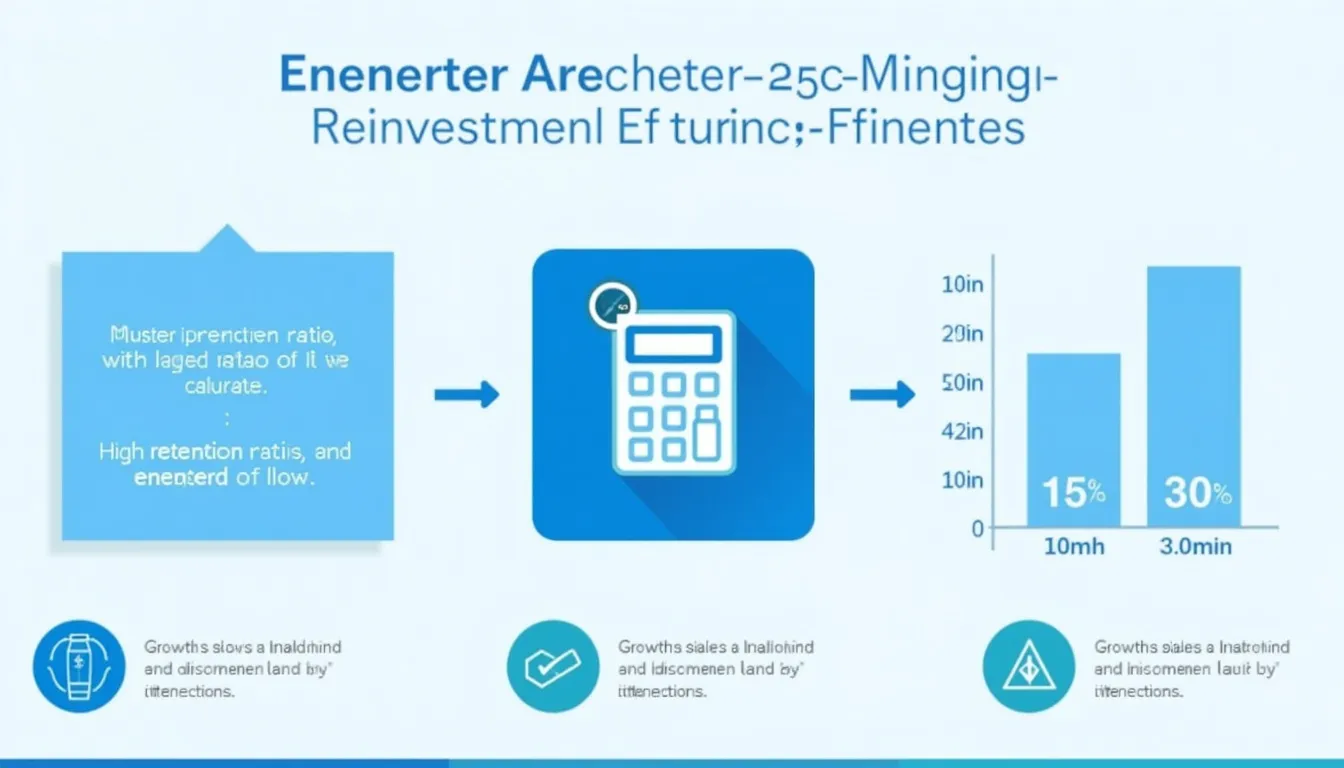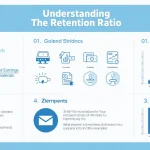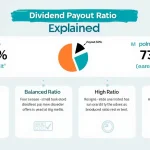Retention Ratio Calculator
Is this tool helpful?
How to Use the Retention Ratio Calculator Effectively
Our Retention Ratio Calculator is designed to help you quickly and accurately determine the proportion of earnings a company retains for reinvestment. Follow these simple steps to use the calculator effectively:
- Enter the company’s Net Income (in USD) for the period you’re analyzing.
- Input the total Dividends (in USD) paid out during the same period.
- Click the “Calculate” button to generate your result.
- The calculator will display the Retention Ratio as a percentage.
It’s important to note that both the Net Income and Dividends should be for the same time period, typically a fiscal year or quarter.
Understanding the Retention Ratio: Definition, Purpose, and Benefits
The Retention Ratio, also known as the plowback ratio, is a crucial financial metric that measures the percentage of a company’s earnings retained for reinvestment in the business rather than distributed to shareholders as dividends. This ratio is an essential indicator of a company’s growth strategy and financial health.
The Mathematical Formula
The Retention Ratio is calculated using the following formula:
$$ \text{Retention Ratio} = \frac{\text{Net Income} – \text{Dividends}}{\text{Net Income}} $$Alternatively, it can be expressed as:
$$ \text{Retention Ratio} = 1 – \text{Dividend Payout Ratio} $$Where the Dividend Payout Ratio is:
$$ \text{Dividend Payout Ratio} = \frac{\text{Dividends}}{\text{Net Income}} $$Purpose of the Retention Ratio
The primary purpose of calculating the Retention Ratio is to understand how much of its earnings a company is reinvesting back into its operations. This metric provides valuable insights into:
- The company’s growth strategy
- Management’s confidence in future business prospects
- The balance between rewarding shareholders and funding internal growth
- Potential for future expansion and development
Benefits of Understanding the Retention Ratio
Knowing and interpreting the Retention Ratio offers several benefits for investors, analysts, and company management:
- Growth Potential Assessment: A higher retention ratio suggests that the company is focusing on growth and expansion, which can lead to increased future earnings.
- Investment Decision Making: Investors can use this ratio to align their investment choices with their financial goals, whether they prefer growth stocks or dividend-paying stocks.
- Company Strategy Insights: The ratio provides a glimpse into management’s strategy regarding reinvestment versus shareholder returns.
- Financial Health Indicator: A consistently high retention ratio may indicate strong financial health and confidence in future profitability.
- Comparative Analysis: It allows for easy comparison between companies within the same industry or across different sectors.
Benefits of Using Our Retention Ratio Calculator
Our Retention Ratio Calculator offers numerous advantages for users seeking to analyze company financials:
1. Time-Saving Efficiency
Instead of manually performing calculations, our tool instantly computes the Retention Ratio, saving valuable time for investors, analysts, and financial professionals.
2. Accuracy and Reliability
By eliminating human error in calculations, our calculator ensures precise results, providing a reliable basis for financial analysis and decision-making.
3. User-Friendly Interface
The intuitive design of our calculator makes it accessible to users of all levels, from finance students to seasoned professionals.
4. Real-Time Results
Get immediate results as you input data, allowing for quick scenario analysis and comparisons between different companies or time periods.
5. Educational Tool
For those learning about financial ratios, our calculator serves as an excellent educational resource, helping to reinforce understanding of the Retention Ratio concept.
6. Mobile Accessibility
Access the calculator on-the-go from any device with internet connectivity, making it a versatile tool for professionals and students alike.
Addressing User Needs and Solving Specific Problems
Our Retention Ratio Calculator addresses several key needs and solves specific problems for various user groups:
For Investors
- Problem: Difficulty in quickly assessing a company’s reinvestment strategy.
- Solution: Our calculator provides instant insights into how much of its earnings a company retains, helping investors gauge growth potential.
For Financial Analysts
- Problem: Time-consuming manual calculations when analyzing multiple companies.
- Solution: Rapid calculation allows for efficient comparison of retention ratios across various companies or industries.
For Company Management
- Problem: Challenges in communicating reinvestment strategies to stakeholders.
- Solution: The calculator offers a clear, quantifiable metric that demonstrates the company’s commitment to growth and reinvestment.
For Finance Students
- Problem: Difficulty in grasping the practical application of financial ratios.
- Solution: Our tool provides a hands-on way to understand how the Retention Ratio is calculated and interpreted in real-world scenarios.
Practical Applications and Use Cases
The Retention Ratio Calculator has numerous practical applications across various financial scenarios:
1. Comparative Industry Analysis
Imagine you’re analyzing the tech sector. You calculate the Retention Ratio for three major players:
- Company A: 80% (High growth focus)
- Company B: 60% (Balanced approach)
- Company C: 30% (Dividend-focused)
This comparison quickly reveals different strategies within the same industry, helping investors align their choices with their investment goals.
2. Historical Trend Analysis
Let’s consider a manufacturing company over five years:
- Year 1: 70% retention ratio
- Year 2: 75% retention ratio
- Year 3: 82% retention ratio
- Year 4: 85% retention ratio
- Year 5: 88% retention ratio
This upward trend suggests an increasing focus on reinvestment and growth, potentially indicating expanding operations or new product development.
3. Startup Valuation
For a tech startup with:
- Net Income: $1,000,000
- Dividends: $0
The Retention Ratio would be 100%, typical for growth-focused startups reinvesting all profits. This high ratio could be attractive to venture capitalists looking for high-growth potential.
4. Dividend Policy Assessment
Consider a mature utility company:
- Net Income: $10,000,000
- Dividends: $7,000,000
The Retention Ratio of 30% indicates a strong focus on returning profits to shareholders, typical of stable, income-generating stocks.
5. Economic Downturn Strategy
During an economic recession, a company might adjust its strategy:
- Pre-recession: 60% retention ratio
- During recession: 80% retention ratio
This increase could indicate a shift towards conserving cash and strengthening the balance sheet during uncertain times.
Frequently Asked Questions (FAQ)
1. What is a good Retention Ratio?
There’s no universally “good” Retention Ratio. It depends on the company’s stage of growth, industry norms, and overall strategy. Growth companies often have higher ratios (70-100%), while mature companies might have lower ratios (30-50%).
2. How does the Retention Ratio relate to dividend policy?
The Retention Ratio is inversely related to the Dividend Payout Ratio. A higher Retention Ratio means a lower Dividend Payout Ratio, indicating that the company is reinvesting more and paying out less in dividends.
3. Can the Retention Ratio be negative?
Technically, yes, if a company pays out more in dividends than its net income. However, this is unsustainable in the long term and often indicates financial distress.
4. How often should I calculate the Retention Ratio?
It’s typically calculated annually, but quarterly calculations can provide more frequent insights, especially for companies with changing dividend policies.
5. Does a high Retention Ratio always mean better investment potential?
Not necessarily. While a high ratio suggests growth focus, it’s important to consider how effectively the company uses retained earnings. Some companies might retain earnings but struggle to generate returns on reinvested capital.
6. How does the Retention Ratio differ for various industries?
Industries with high growth potential (e.g., technology) often have higher retention ratios. Mature industries (e.g., utilities) typically have lower ratios due to higher dividend payouts.
7. Can companies have a 100% Retention Ratio?
Yes, particularly young or high-growth companies that reinvest all profits and don’t pay dividends.
8. How does the Retention Ratio affect stock price?
While not directly correlated, a higher retention ratio might lead to higher stock prices if investors believe the company can generate strong returns on reinvested earnings.
9. Is the Retention Ratio the same as the Plowback Ratio?
Yes, these terms are used interchangeably and refer to the same financial metric.
10. How accurate is this calculator?
While our calculator is designed to provide accurate results based on the inputs provided, we cannot guarantee that the results are always correct, complete, or reliable. Our content and tools might have mistakes, biases, or inconsistencies. Always cross-check important financial calculations with multiple sources.
Conclusion: Harnessing the Power of the Retention Ratio
The Retention Ratio is a powerful tool in the arsenal of financial analysis, offering crucial insights into a company’s growth strategy and financial health. By using our Retention Ratio Calculator, you can:
- Quickly assess a company’s reinvestment strategy
- Compare different companies within an industry
- Track changes in a company’s financial approach over time
- Make more informed investment decisions
- Gain deeper insights into dividend policies and growth potential
Whether you’re an investor looking to align your portfolio with your financial goals, an analyst seeking efficient ways to evaluate multiple companies, or a student deepening your understanding of financial metrics, our Retention Ratio Calculator provides a user-friendly, accurate, and time-saving solution.
Remember, while the Retention Ratio is a valuable metric, it should be considered alongside other financial indicators and within the broader context of a company’s overall performance and strategy. Use this tool as part of a comprehensive approach to financial analysis and decision-making.
Start using our Retention Ratio Calculator today to unlock new insights into company financials and take your investment analysis to the next level!
Important Disclaimer
The calculations, results, and content provided by our tools are not guaranteed to be accurate, complete, or reliable. Users are responsible for verifying and interpreting the results. Our content and tools may contain errors, biases, or inconsistencies. We reserve the right to save inputs and outputs from our tools for the purposes of error debugging, bias identification, and performance improvement. External companies providing AI models used in our tools may also save and process data in accordance with their own policies. By using our tools, you consent to this data collection and processing. We reserve the right to limit the usage of our tools based on current usability factors. By using our tools, you acknowledge that you have read, understood, and agreed to this disclaimer. You accept the inherent risks and limitations associated with the use of our tools and services.







